Crucial Things You Need To Know About External Links
When creating content, it’s common to consult a variety of sources to gain a full understanding of the subject. No matter the field or topic being addressed, there will be occasions where it becomes necessary to cite information from research studies or quote established figures. This is where external linking comes into play as part of your SEO strategy.
In this article, we’ll cover best practices for external linking and explore effective methods for finding, monitoring, and fixing external links.
-
Benefits of external links
Relevant external links enrich the user experience by directing visitors to additional, valuable resources. Linking to authoritative sources—especially for YMYL (Your Money or Your Life) topics—builds trust and can boost SEO. Search engines view credible outbound links positively, which can enhance a site’s authority and relevance.
-
Risks of external links
Improper use, such as excessive or low-quality linking, can result in penalties. Link spamming and purchasing links without proper attributes (like rel=”nofollow”) are against Google’s guidelines. Plus, misleading or irrelevant links can degrade the user experience, affecting trust and engagement.
-
Best practices
A useful external hyperlink should come from a credible and relevant source, with high domain authority, secure protocols, and content that aligns with the topic for added value and SEO impact.
-
Regular monitoring and maintenance
Regular audits help keep links updated and relevant. Tools like SE Ranking’s Website Audit identify broken or misattributed links, enhancing both SEO and user experience.
What are external links?
An external link refers to any link that is present on your website and goes to another website. These links can be:
- Placed in text, images, or buttons.
- Attributed as either dofollow or nofollow, with the latter telling search engines not to vouch for the link (more on that later).
- Visible or hidden from website visitors.
Naturally placed external links are usually underlined or marked by another color. On the screenshot below, you can see an example of an external link:
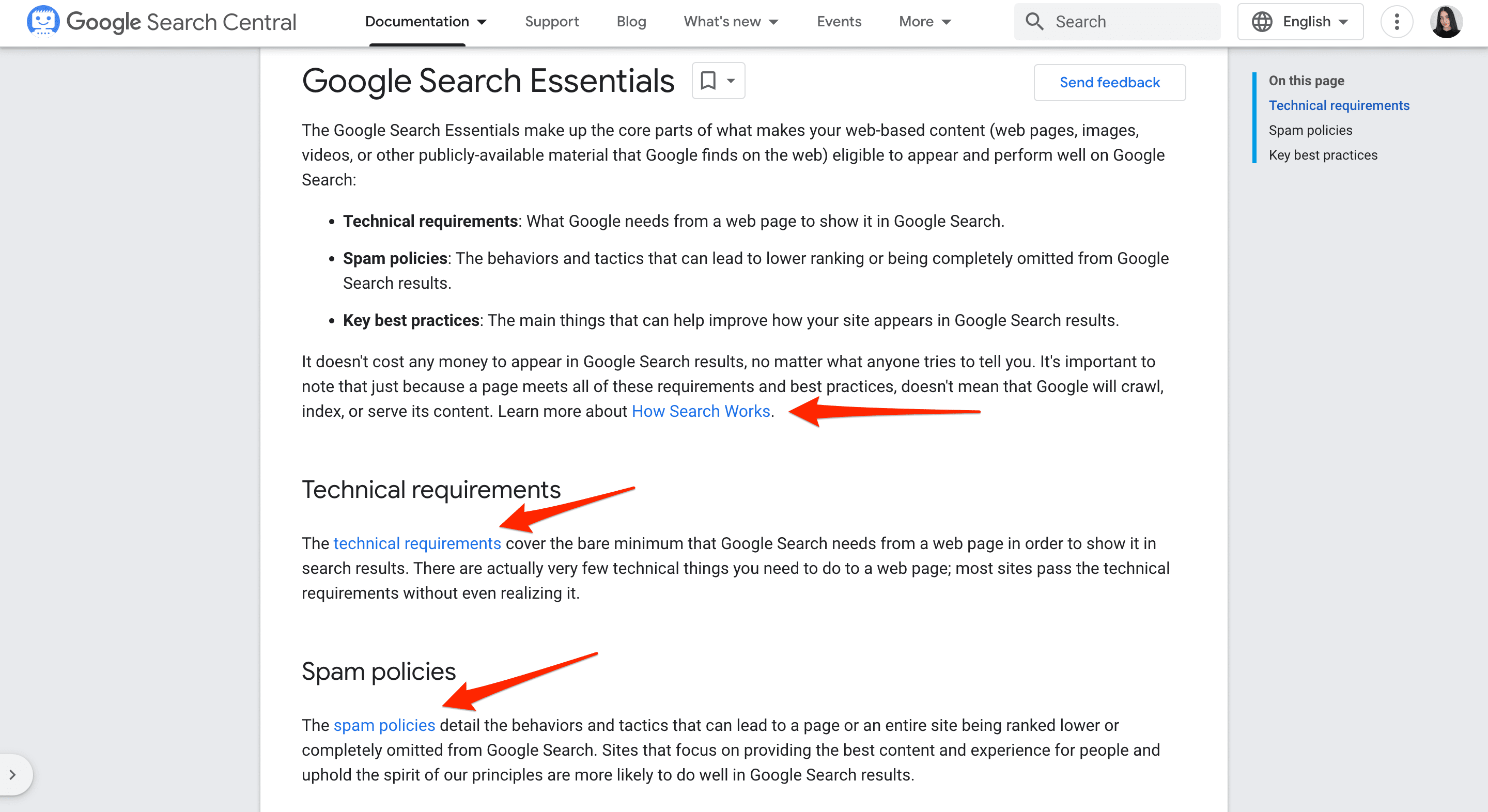
In the HTML code, a typical external link appears as follows:
Read our <a href="http://www.yoursite.com/post">recent post</a> to learn about the latest SEO trends.
In this example, the <a> tag represents an HTML tag for hyperlinks. The href is the attribute that specifies the link’s destination, and the “recent post” text serves as an anchor text that describes to readers what they will access by following the link.
External vs. internal links: What’s the difference?
- Internal links connect different pages within the same website. They help users navigate the site and assist search engines in understanding the site structure.
- External links point from one website to a different website. They are generally used to offer references, citations, or additional resources.
What makes an external link useful for sites?
There are three principles that make outbound links effective.
First, the source must be credible. Second, it should be relevant to the content of the page where you’re placing the link. Third, it should have the appropriate attribute. Let’s review these principles more closely.
Credibility and trust markers
How can you determine whether a website is spammy or trustworthy beyond simply visiting it and evaluating how it looks? You should check several parameters to make an informed decision:
- Domain authority. There are different metrics for evaluating domain quality. SE Ranking has its own called the Domain Trust score, which puts a domain on a logarithmic scale from 0 to 100. The bigger is the score, the higher the quality of the domain’s backlink profile. Unfortunately, this metric can be manipulated, so don’t rely solely on it without considering other factors.
- Domain history. You can visit the Wayback Machine and check the domain’s archive to learn more about its early days and historical consistency.
- Website security. Ensure that the source you’re going to quote uses a safe protocol and has no security-related issues. To learn more, check our post on website security.
- Anchor texts. Examine the anchor texts used by sources linking to the website of interest. If you find any spammy anchor texts or ones that are stuffed with commercial keywords or brand names, then they probably are not your best choice. You’ll have much better luck best using SE Ranking’s tool to check backlinks and analyze anchor texts.
- Keywords a website ranks for. If the website ranks well for relevant keywords, this indicates that it has authority and expertise in that area. Review the search queries for which the analyzed website appears. SE Ranking’s Competitive Analysis gives you a list of keywords a domain ranks for—analyze them for quality and relevance to the industry.
For example, if you’re writing about healthy nutrition, discovering a website that ranks high for keywords like “nutrition tips” and “healthy diet,” indicates that the website is authoritative in that field. This helps maintain the quality and credibility of your content, while providing valuable resources to your readers.
On the other hand, if you encounter a website that ranks for irrelevant keywords, make sure to cross-check information from authoritative sources that specifically focus on your topic. Otherwise, relying solely on a website that ranks for irrelevant keywords may lead to inaccurate information and undermine the credibility of your own content.
- Balance between referring and linked domains. In the Competitive Analysis tool, you’ll see the number of referring domains. It’s recommended to also check the number of linked domains. A significant imbalance could indicate a low-quality source.
- Quality of backlinks. Go through the backlinks of the top website to ensure there are no links from spammy sources. For more details on backlink quality, read our post on key backlink parameters.
- Geographical distribution of traffic. Determine the locations from which a domain’s traffic originates. Once again, you can use tools like SE Ranking’s Competitive Research to do so. Under the Overview tab, you’ll find the Traffic Distribution by Country report, which provides data on organic and paid traffic for each available region.
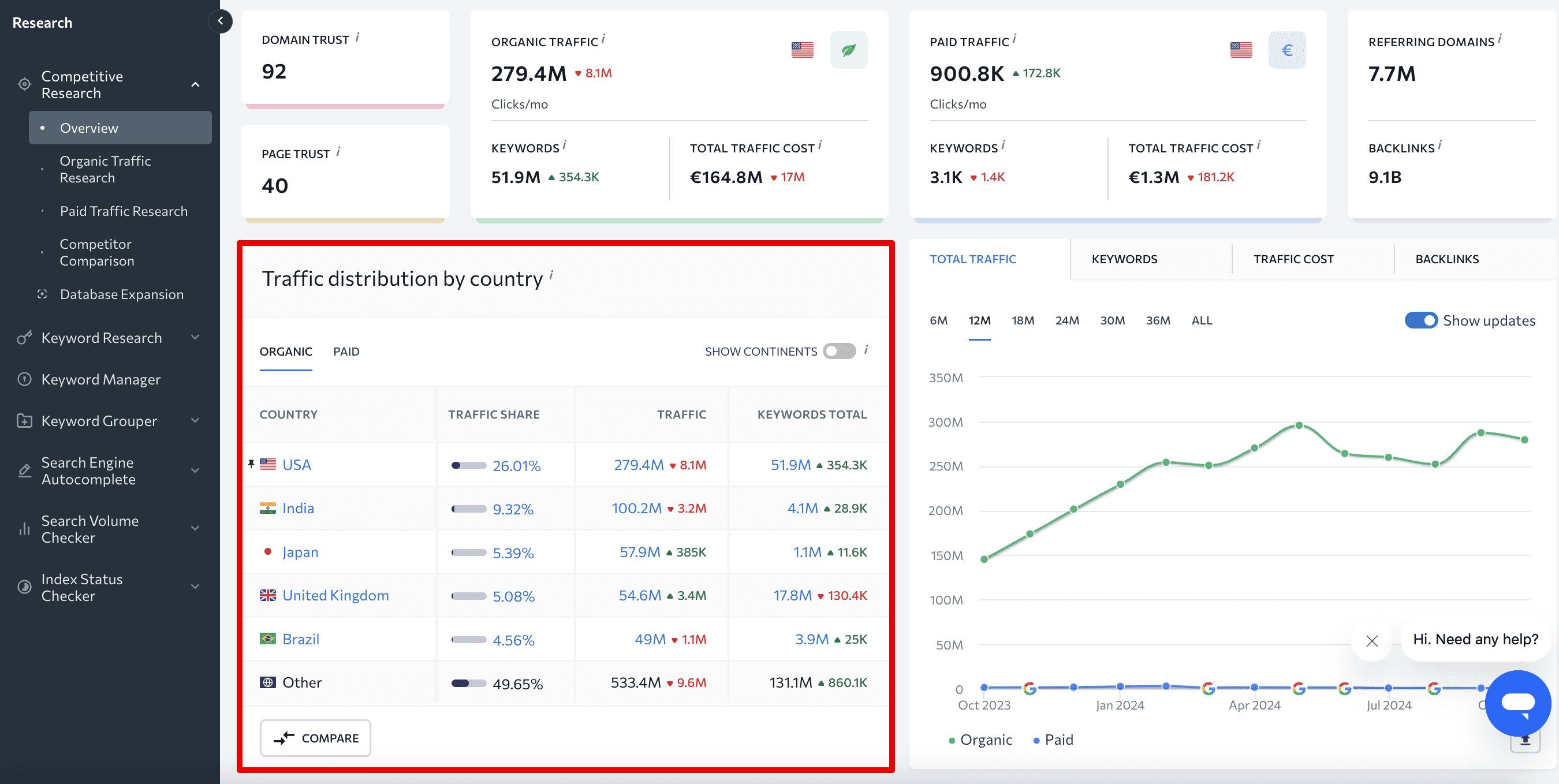
- Top performing pages. Get to know a website better by examining which pages bring in the most traffic. SE Ranking’s Competitive Analysis tool includes a Pages section, which displays a full list of website URLs along with information on traffic volume and keyword count.
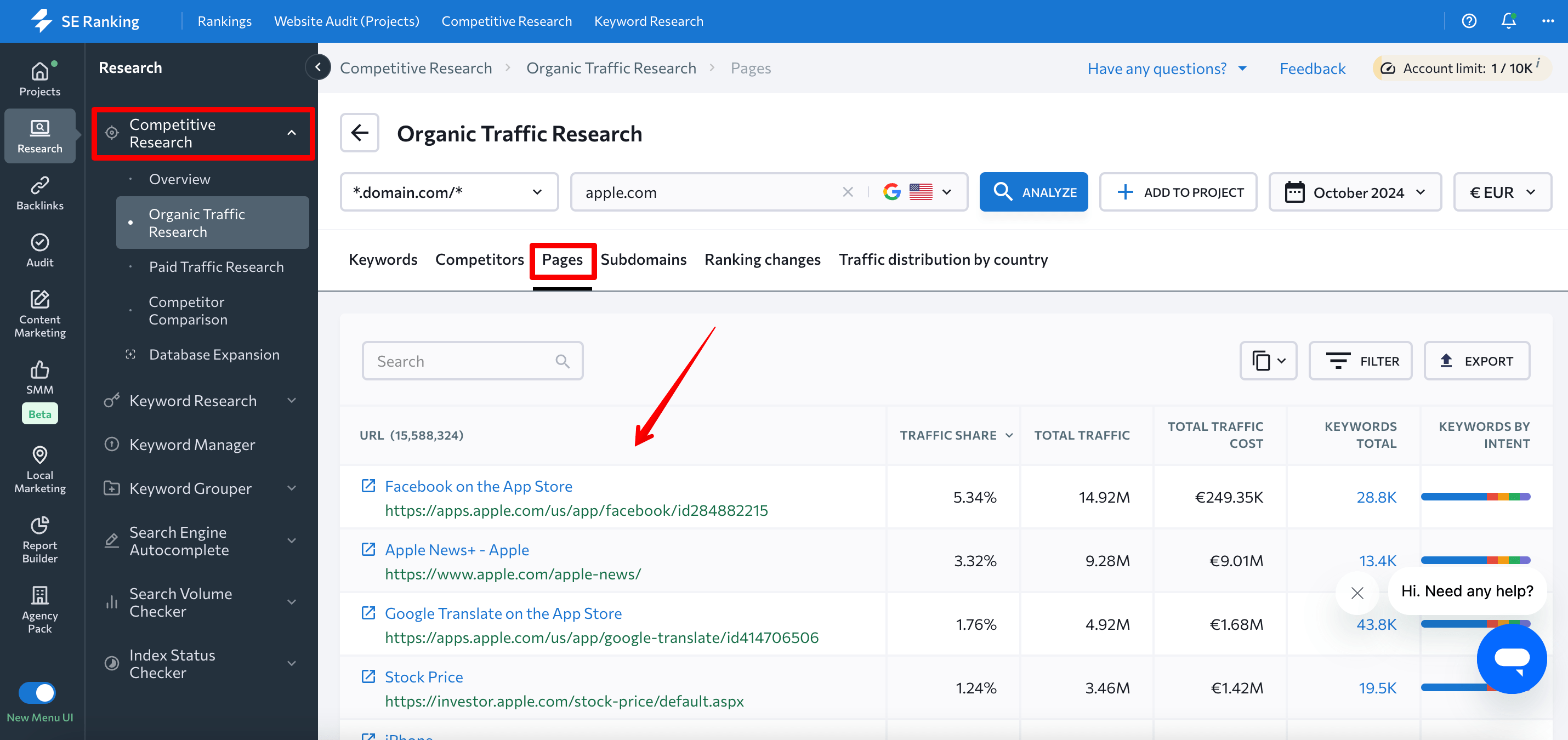
When evaluating a specific page for reference, consider the:
- Quality of the content. This factor comes naturally. After reading through the content you intend to use, make sure the page conveys your intended message and follows Google’s E-E-A-T and YMYL criteria.
- Traffic and keyword relevance. Check how much traffic a page gets and how relevant the keywords it ranks for are.
When creating content, you will gradually build a base of sources that you trust, but it never hurts to recheck. Websites can change, so you want to make sure you’re never making connections with an inappropriate website.
The importance of relevance
To assist searchers in the best way possible, search engines have evolved to understand the connections between different topics. They have become adept at identifying any irrelevant content that it is linked to. With that said, when you support some statement with an external link, it must be a source that is relevant to what your content is about. Comprehensive anchor texts also have to be relevant and help readers understand what they’ll get if they follow the link.
You should also consider referring to updated information. Google has a freshness algorithm that assesses how fresh a page is. It does this by examining the overall volume of newly published content about a given topic.
Proper rel attributes
To give search engines clear information about the purpose of an external link, use the appropriate rel attribute. This allows search engines to understand whether a link is sponsored, user-generated content, or not endorsed by the website owner.
The following are the most commonly used rel attributes for external links:
- rel=”sponsored”
The rel=”sponsored” attribute should be used (as its name suggests) to indicate that the link is part of sponsored or ad-related content. In other words, you must include this attribute in your link if you get paid for a link, whether it’s a sponsored, affiliate, or other paid link. Neglecting to label these links as sponsored may result in penalties.
While rel=”nofollow” can still be used for paid links, Google states that sponsored should be the “preferred” option for the external linking strategy.
- rel=”ugc”
This attribute is used for user-generated content, such as comments and forum posts. It signifies that the linked content is not endorsed by the website owner and is generated by users. By using the rel=”ugc” attribute, search engines gain clarity regarding the website’s official content. This attribute also helps search engines better understand the context of the linked content.
- rel=”nofollow”
This attribute is used to indicate that the website owner does not endorse the linked content, and the link should not affect the linked website’s search ranking. Websites often use this attribute for links to untrusted or low-quality websites to prevent their website from being associated with spammy or harmful content. It’s important to note that search engines may still follow and crawl nofollow external links, but they will not pass any link equity to the linked website.
- Multiple values
Website owners are encouraged to include multiple rel attribute values for a single link to provide more context to search engines. For example, a link containing both sponsored and user-generated content can include the following rel attribute: rel=”sponsored ugc”. Attributes can be mentioned both in a space- or comma-separated list (e.g., rel=”sponsored, ugc”).
Are external links helpful for SEO?
There are several key benefits of external links:
- Better user experience: By including relevant links, you make it easier for readers to explore some materials they might be interested in and learn more about any details or facts mentioned by you.
- Enhanced credibility and trustworthiness: If you make statements supported by statistics, website visitors are more likely to perceive this as information they can trust, check, and refer to.
To produce high-quality content that effectively incorporates external links, SE Ranking’s Content Marketing Tool is an invaluable resource. With this tool, website owners can optimize their content strategy by creating an anchor plan for their content that outlines the relevant links to be included in their articles.
- Improved website’s authority: If you incorporate useful outbound links into your content, search engines will recognize that you are providing additional value to your readers by directing them to credible sources. This increases the site’s chances of ranking well in SERPs. To illustrate this point, a study conducted by Reboot in 2020 confirmed that relevant outbound links to authoritative sources have a positive impact on a website’s rankings.
- Enhance your website’s relevance: Incorporating external links that complement and expand upon your article’s content enables Google to better grasp the purpose and intent of your web page. Doing this also significantly increases your chances of ranking for relevant queries and delivering the best solutions to user requests. When it comes to YMYL (Your Money or Your Life) topics, such as health, safety, finances, law, etc, Google places a premium on all content backed by reliable sources.
- Boost your reach and initiate link building relationships. Think of linking to another website as an opportunity to establish potential link building relationships. For instance, if you’re writing a blog post on top productivity apps and include links to each, consider reaching out to the site owners or representatives. Encourage them to share your article in their newsletters or on social media. Similarly, if your site represents one of these apps, reach out to media sources you’ve referenced—they may feature your product in return.
But an outbound link can also cause you damage.
The biggest risk of using external links incorrectly is link spam, which manipulates search engines through artificial links. Link spamming takes various forms, including excessive link exchanges, automated link generation, or buying and selling links for ranking purposes. This is considered a black hat SEO technique. Google’s guidelines strictly prohibit this practice, as it can harm both the linking and linked websites.
Beyond SEO, link spam can also degrade user experience. Users may encounter irrelevant or misleading links or be directed to sites with low-quality content or ads.
Google recognizes that buying and selling links is common in online business. To comply with Google’s guidelines, these links should include a rel=”nofollow” or rel=”sponsored” attribute in the <a> tag, which signals to Google that the link should not pass ranking value.
How to find external links for a website?
Firstly, it is crucial to find all the outbound links on your site to identify any broken links. Broken links can damage both user experience and your site’s rankings. When crawlers stumble on an excessive amount of 404 errors, the website’s authority drops in the eyes of search engines.
If broken external links are discovered, you have several options:
- Reach out to sources you’ve referenced
- Replace links with up-to-date ones
- Simply remove them
After you find external links, you can check each one manually or use an external link checker to identify any non-functional links. This process will help you maintain the quality of your website and ensure a smooth user experience.
Alternatively, you can conduct a technical SEO audit using SE Ranking’s Website Audit tool to find and examine external links that may be impacting your site’s performance and user experience. The Links section under the Issue Report will identify if there are any timed-out links or if there are links without anchor texts, allowing you to ensure everything is as planned. You can also review all the nofollow links.
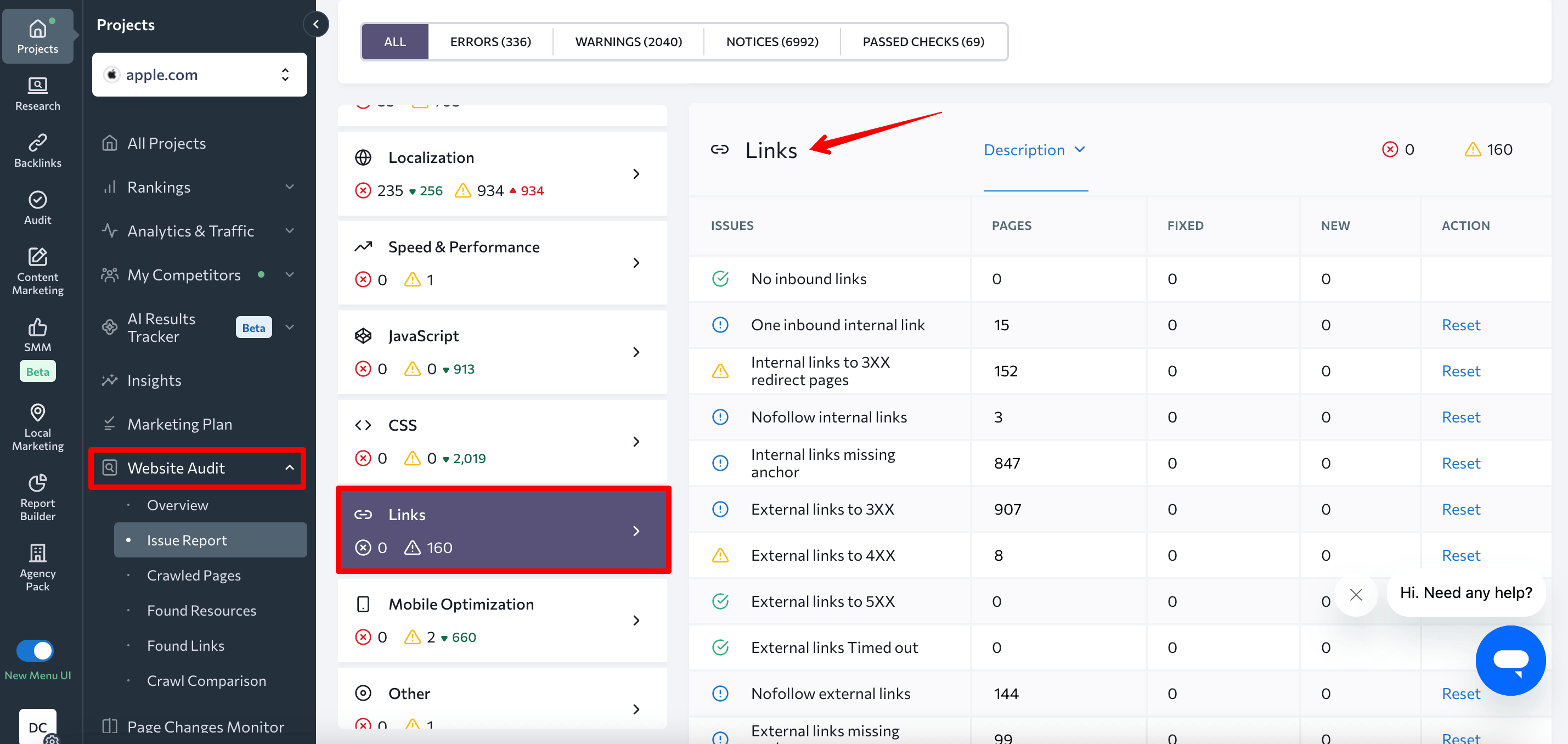
For any issue identified by the system, you’ll get a full list of links that can be exported in .xls:
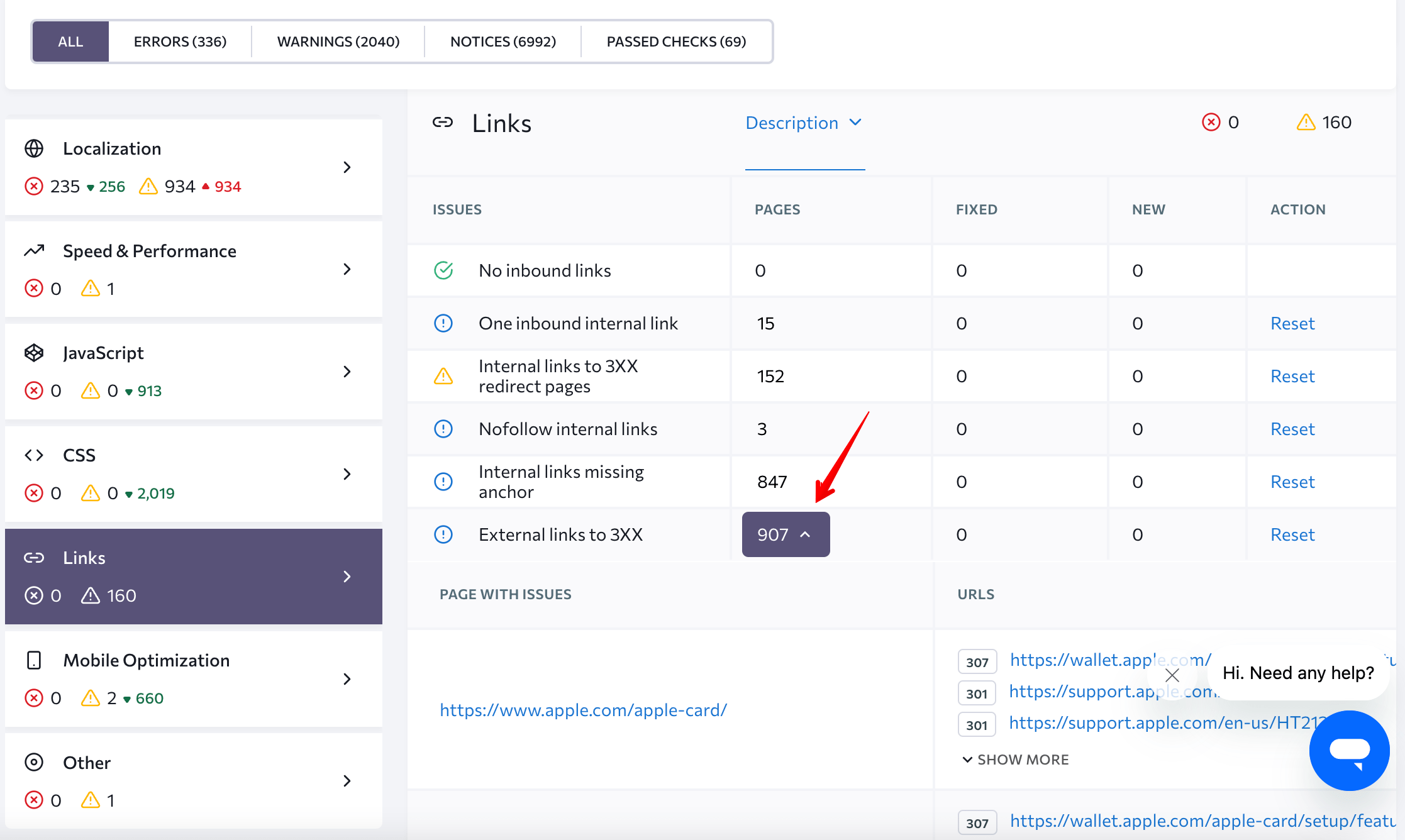
You can also use this tool to analyze the external links of your competitors’ pages and gain valuable insights into their content strategy. By identifying the top pages that are being referenced by others, you can determine which sources are considered authoritative in your industry. This information can help you develop your content further by incorporating references to these sources, making your content even more useful and relevant to your audience.
Monitoring and fixing external links
By keeping your external links up-to-date and of high quality, you can improve your site’s user experience and SEO ranking. Monitoring and fixing external links is especially important because:
- Websites can change their URLs, rewrite their content, or even shut down entirely. When this happens, any external links to that website will become broken or lead to irrelevant content, negatively impacting your site’s user experience and SEO. To avoid this problem, regularly check and update your external links.
- Outbound links are a ranking factor for search engines. If you link to low-quality or spammy websites, it can harm your site’s reputation and SEO ranking. Always ensure the quality of your outbound links and that they lead to relevant and reputable sources.
To make the task of monitoring external links easier, there are several SEO tools available, such as SE Ranking’s Webpage Monitor. This tool tracks the changes of all external links on your website and alerts you of any modifications, including URL changes or content updates. With this tool, you can easily fix any broken links and ensure your outbound links are relevant and of high quality.
To sum it up
By linking to other websites, you prioritize the interest of your readers and assist search engines in connecting relevant sources. The key aspect of external linking is to naturally incorporate the most relevant and valuable links into your content. When done properly, outbound linking will improve user experience and search engine rankings, making your website more credible and authoritative.
Tools like SE Ranking’s Website Audit provide you with a list of all external links (along with brief explanations of issues associated with them) and quick tips on how to address them. By following the suggested recommendations, you’ll be able to boost your website’s credibility and reputation, leading to increased organic traffic and conversions.

